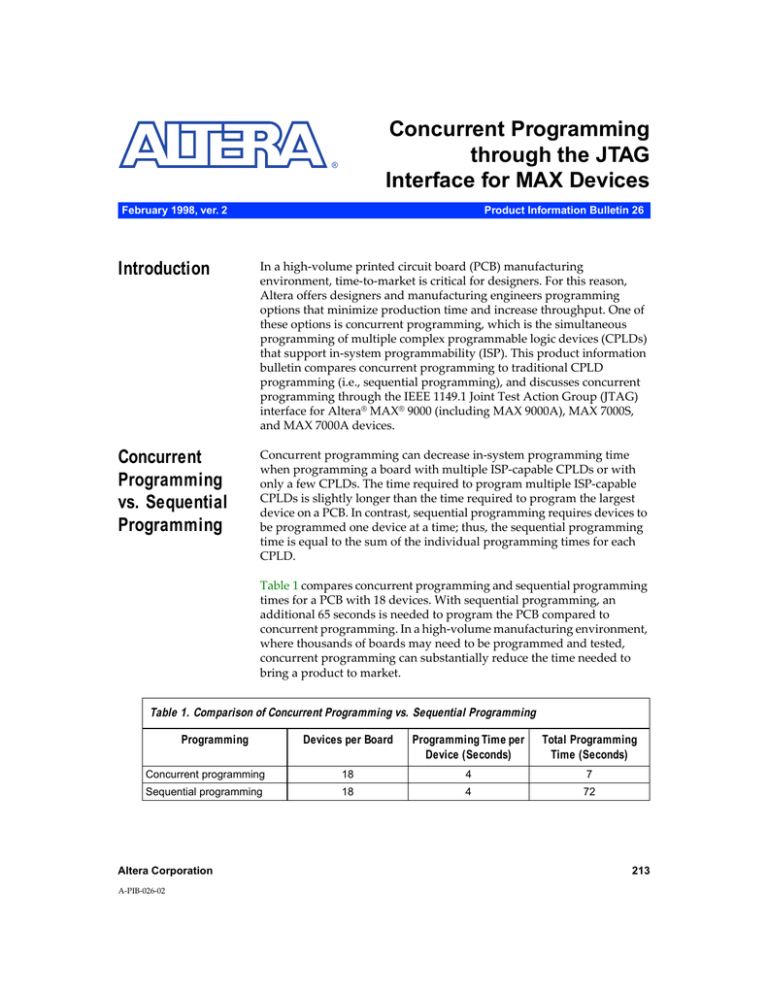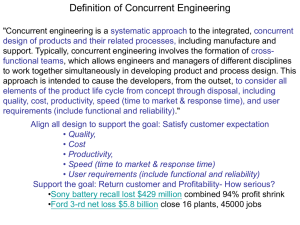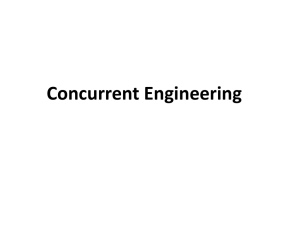
Concurrent Programming
through the JTAG
Interface for MAX Devices
®
February 1998, ver. 2
Product Information Bulletin 26
Introduction
In a high-volume printed circuit board (PCB) manufacturing
environment, time-to-market is critical for designers. For this reason,
Altera offers designers and manufacturing engineers programming
options that minimize production time and increase throughput. One of
these options is concurrent programming, which is the simultaneous
programming of multiple complex programmable logic devices (CPLDs)
that support in-system programmability (ISP). This product information
bulletin compares concurrent programming to traditional CPLD
programming (i.e., sequential programming), and discusses concurrent
programming through the IEEE 1149.1 Joint Test Action Group (JTAG)
interface for Altera® MAX® 9000 (including MAX 9000A), MAX 7000S,
and MAX 7000A devices.
Concurrent
Programming
vs. Sequential
Programming
Concurrent programming can decrease in-system programming time
when programming a board with multiple ISP-capable CPLDs or with
only a few CPLDs. The time required to program multiple ISP-capable
CPLDs is slightly longer than the time required to program the largest
device on a PCB. In contrast, sequential programming requires devices to
be programmed one device at a time; thus, the sequential programming
time is equal to the sum of the individual programming times for each
CPLD.
Table 1 compares concurrent programming and sequential programming
times for a PCB with 18 devices. With sequential programming, an
additional 65 seconds is needed to program the PCB compared to
concurrent programming. In a high-volume manufacturing environment,
where thousands of boards may need to be programmed and tested,
concurrent programming can substantially reduce the time needed to
bring a product to market.
Table 1. Comparison of Concurrent Programming vs. Sequential Programming
Programming
Devices per Board
Programming Time per
Device (Seconds)
Total Programming
Time (Seconds)
Concurrent programming
18
4
7
Sequential programming
18
4
72
Altera Corporation
A-PIB-026-02
213
PIB 26: Concurrent Programming through the JTAG Interface for MAX Devices
Programming
through the
IEEE 1149.1
(JTAG)
Interface
Concurrent programming of ISP-capable CPLDs through the IEEE 1149.1
JTAG interface reduces the complexity of the manufacturing process.
During production, implementing ISP through the JTAG interface allows
all ISP-capable devices to be chained together in a JTAG chain,
simplifying programming and testing. The JTAG chain can be extended to
include non-ISP-capable JTAG devices for easier device testing. The time
required to program the JTAG chain is slightly longer than the time
required to program the largest device in the chain.
Concurrent
Programming
in Altera ISPcapable CPLDs
Altera ISP-capable CPLDs allow devices within the same family to be
concurrently programmed, reducing programming times. Data is serially
shifted into multiple devices along the JTAG chain, and then
programming pulses are applied simultaneously to all the devices.
Figure 1 illustrates concurrent programming through a JTAG chain of
three Altera MAX 9000 devices.
Figure 1. Concurrent Programming of Three MAX 9000 Devices through an
IEEE 1149.1 JTAG Chain
TDO
TMS
TCK
TCK
TMS
EPM9560
TDI
TDI
TDO
TCK
TMS
EPM9320
TDI
TDO
TCK
TMS
EPM9480
TDI
TDO
The time required to concurrently program multiple devices in a JTAG
chain can be calculated from the following formula:
Cycle PTCK
t PROG = t PPULSE + ∑ --------------------------f TCK
All Devices
where: tPROG
tPPULSE
= Programming time
= Sum of the fixed times to erase, program, and
verify the EEPROM cells for only the largest device
CyclePTCK = Number of test clock (TCK) cycles to program each
device
fTCK
= TCK frequency
Table 2 shows the concurrent programming times for 1, 2, 10, and 100
devices in a JTAG chain.
214
Altera Corporation
PIB 26: Concurrent Programming through the JTAG Interface for MAX Devices
Table 2. Concurrent Programming Times
Family
MAX 9000
MAX 7000S
MAX 7000A,
Note (2)
Programming Times (Seconds) Note (1)
Device
1 Device
2 Devices
10 Devices
100 Devices
EPM9560, EPM9560A
12.25
12.49
14.43
36.24
EPM9480, EPM9480A
12.05
12.27
14.07
34.26
EPM9400
11.85
12.06
13.70
32.24
EPM9320, EPM9320A
11.65
11.84
13.34
30.21
EPM7256S
6.57
6.71
7.82
20.27
EPM7192S
5.82
5.93
6.80
16.60
EPM7160S
5.47
5.57
6.30
14.61
EPM7128S
5.19
5.27
5.89
12.86
EPM7064S
4.62
4.67
5.05
9.37
EPM7032S
4.33
4.37
4.63
7.62
EPM71024A
3.07
3.19
4.13
14.78
EPM7512A
3.01
3.07
3.54
8.88
EPM7384A
3.00
3.04
3.40
7.41
EPM7256A
6.57
6.71
7.82
20.27
EPM7128A
5.19
5.27
5.89
12.86
EPM7064A
2.96
2.97
3.02
3.65
EPM7032A
2.95
2.96
2.99
3.30
Note:
(1)
(2)
Times are provided for devices programmed at a TCK frequency of 10 MHz.
Programming times for MAX 7000A devices are preliminary. For more information, contact Altera Applications at
(800) 800-EPLD.
A Jam File (.jam) or Serial Vector Format (.svf) File can be used to
concurrently program MAX 9000, MAX 7000S, or MAX 7000A devices.
Both of these file formats use concurrent programming algorithms
exclusively. An in-circuit tester or embedded processor shifts in data and
perform concurrent programming. Designers using Altera devices and
ISP benefit from this process on the manufacturing floor, because
concurrently programming a device with in-circuit testers decreases the
programming time, thereby decreasing the production time. You can use
the Create Jam or SVF File dialog box in the MAX+PLUS® II software to
create Jam or SVF Files. See Figure 2.
Altera Corporation
215
PIB 26: Concurrent Programming through the JTAG Interface for MAX Devices
Figure 2. Create Jam or SVF File Dialog Box
f
216
For more information on using concurrent programming for Altera
ISP-capable CPLDs, see AN 39 (JTAG Boundary-Scan Testing in Altera
Devices) and AN 85 (In-System Programming Times for MAX 9000 &
MAX 7000S Devices) in this handbook.
Altera Corporation
Copyright © 1995, 1996, 1997, 1998 Altera Corporation, 101 Innovation Drive,
San Jose, CA 95134, USA, all rights reserved.
By accessing this information, you agree to be bound by the terms of Altera’s
Legal Notice.



